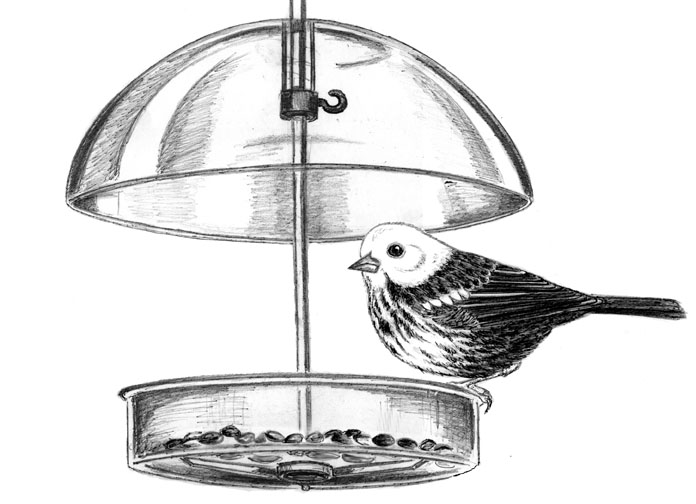
Dear Bird Folks,
I have a leucistic sparrow coming to my yard. It looks and acts exactly like a Song Sparrow only its head is white, like it was dipped in white chocolate. How did the bird get this way?
– Chris, Brewster, MA
Not another one, Chris,
Not another hard-to-pronounce topic. Last week it was about a bunting called a “lazuli.” Before that we wrote about “jacanas.” And let’s not forget about the debate on the proper way to say “Gyrfalcon.” Can’t we talk about something easier to pronounce like ducks, crows or Pyrrhuloxias? What’s with all the tough tongue twisters lately? Remember tongue twisters? I used to be pretty good at them, but some of the bird tongue twisters give me a lot of trouble. Saying “Peter Piper picked a peck of pickled Pyrrhuloxias” almost put me in the hospital.
Leucistic (lew-sis-tic) is an unusual condition in birds that is so rare the word isn’t even in most dictionaries. Really. (Go ahead, look. You’ll see.) The feathers of a leucistic bird have little or no coloring. I wrote about this topic a few years ago. I usually won’t write about the same obscure topic twice, but after rereading that old column I noticed I made quite a few jokes about Michael Jackson (who was very much alive at the time) and his changing skin color. In 2012 those same jokes seem a little inappropriate. So I’m going to rewrite the column, but without poking fun at a disease that afflicted a fragile musical superstar. Sorry, MJ. RIP. (There, that should keep me out of Hell for a few more days.)
The reason Michael Jackson seemed to change from a black man to a white guy is because he had a condition known as “vitiligo” in which the color-producing melanin cells in his body stopped working. With leucistic birds these cells never worked to begin with. Most leucistic birds are born that way. This subject has baffled researchers for years. Most can’t even agree on what separates a leucistic bird from an albino. To keep things simple, an albino has no coloring anywhere, even in the eyes. (What about their pink eyes, you ask? The pink is not an eye color; it’s the blood shining through their colorless eyes. Freaky, eh?) Leucistic birds are not albinos. They have some coloring, just not everywhere. Some leucistic birds may only have a few white feathers, while others have tons. Sometimes their feathers aren’t white or dark, but simply paler than usual, thus all the confusion. Keep in mind we aren’t talking about birds that are supposed to be white. The startlingly white Ivory Gull, for example, is not an albino or leucistic; it’s just cool.
The varying degrees of white feathering on a bird can give bird watchers fits and cause complete hysteria in non-birders. Your sparrow has a white head, while another leucistic bird might have a white tail and yet another might have a white head, tail and wings. How people identify these birds depends upon their birding skills. You were able to ID your white-headed Song Sparrow, Chris, but someone else may have mistakenly thought it was a Snow Bunting, miniature Bald Eagle or flying baby skunk. The best way to identify one of these odd birds is to watch its homies. If a strange bird is hanging out with, say, Mourning Doves, and it looks a dove, except for the odd coloring, it’s probably a Mourning Dove.
There are tons of pics of leucistic birds on the Internet. One of my favorites is of a Pileated Woodpecker. The bird is all white, except for the head-crest, which is its normal bright red. It looks like a ghost with some kind of head trauma. Why was the head-crest red and not white like the rest of the bird? Good question. I’m glad you asked. The dark feathering of a bird is produced by melanin. When there is no melanin the feathers are white. But red feathers don’t need melanin; they are a product of carotenoids. (Exciting stuff, eh?) The bird’s lack of melanin didn’t affect the carotenoids and thus the head-crest was its customary red. Even penguins can have this problem. I saw a photo of a leucistic penguin standing on an ice floe with a group of other penguins. The bird seemed fine, except it was all white. Sadly, all of the other penguins totally ignored this odd bird. They weren’t trying to be cruel, but with all the snow and ice around I don’t think they could see it.
Leucistic birds are rare, but they aren’t unheard of. I know of at least two other strangely colored birds in the area. One lady has a pale robin in her yard and another guy has a washed-out chickadee on his feeder. Part of the reason leucistic birds are so unusual is because they aren’t likely to reproduce. A sparrow with flashes of light coloring is an obvious target for predators. The other problem is breeding. Nothing wants to mate with something that’s unusually bright white, which explains why it took me so long to have children.
Nice job identifying your strange Song Sparrow, Chris. I really like your description of it looking like a bird that had its head dipped in white chocolate. Just don’t expect to ever see a bird that has had its head dipped in dark chocolate. That’s because the bird would immediately lap off the dark chocolate. But even birds know better than to eat nasty white chocolate.